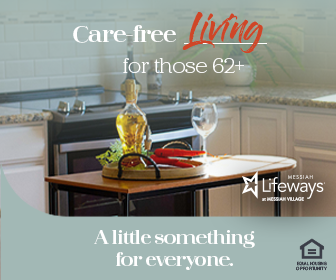Personal Care Homes (PCH) and Assisted Living Residences (ALR) are housing options typically for older adults that provide hands-on care with activities of daily living such as bathing, dressing, grooming and offer three meals a day, activities and medication monitoring.
Wondering how much assisted living or personal care costs in PA? The average annual cost of a personal care home or assisted living in Pennsylvania is $41,400¹. While some older Pennsylvanians are fortunate enough to pay privately for these services, a much larger percentage simply cannot. Either way, many of those who need these levels of care are often mistaken on how it will get paid for.
Many seniors and/or their families think that Medicare or Medicaid (aka Medical Assistance) will pay for some or all of personal care or assisted living. But, regrettably neither offer coverage in Pennsylvania, therefore private out-of-pocket payment tends to be the primary funding source for PA seniors. But, a fair number of states like Florida, North Carolina and Maryland do provide full coverage through their state Medicaid program. For full details on all 50 states, click [here].
For many older Pennsylvanians who begin to decline and struggle to live safely at home, moving to a personal care home can be the perfect solution. However, again due to average monthly costs of $3,450¹, it’s just not an option for many.
Of course this is nothing new, so state funded programs through Home and Community Based Services (HCBS), also known as Waiver Funded Services or Waiver Programs, were created to provide alternatives. They provide support and services that enable individuals to remain in a community setting rather than being admitted to a long-term care facility. Some of these waiver funds particularly aimed at helping seniors include adult day programs, non-medical home care, home modification grants and environmental adaptation services. While these are helpful, they may fall short for someone who cannot live alone safely 24 hours a day, for instance those with a dementia diagnosis. In cases where placement is an absolute must, the other option is nursing home placement; because if financially eligible, Medicaid will pay for them to be in a nursing home. The problem with this is that a number of these people don’t actually need true nursing care. For example, someone with moderate dementia may be in decent physical health, but because of safety or behavioral issues coupled with little income and no assets, nursing placement becomes the only option. Thus – “becoming stuck between a rock and a hard place.”
Some good news
There are two direct funding sources that will provide partial or possibly full coverage for PCHs and ALRs in PA. The first is Supplemental Security Income (SSI) and second is the Aid and Attendance Pension Benefit through the U.S. Department of Veterans Affairs.
Not to be confused with Social Security income that most everyone receives after retirement, Supplemental Security Income is strictly a needs-based program determined by one’s income and assets and, of course, physical need. It exists for people age 65+, as well as blind or disabled people of any age, including children.
To meet the SSI income requirements, you must have less than $2,000 in assets (or $3,000 for a couple) and a very limited income. SSI provides a number of benefits like the Supplemental Nutrition Assistance Program (SNAP), formerly known as food stamps. It also provides a monthly payment for the PA “Domiciliary Care or “Dom Care” program. As stated on PA Aging website, “Dom Care was created to provide a home-like living arrangement in the community for adults age 18 and older who need assistance with activities of daily living and are unable to live independently. Dom care providers open their homes to individuals who need supervision, support, and encouragement in a family-like setting.
Dom care residents are matched to homes that best meet their special needs, preferences, and interests. Dom care homes are smaller than the traditional personal care home in that home providers care for no more than three dom care residents. Unlike larger personal care homes, dom care homes are the individual providers’ homes. They are inspected annually to ensure they meet health and safety standards. If the home and provider pass this inspection, they become certified.
The local Area Agency on Aging is responsible for the initial certification and ongoing annual inspections of Dom Care homes in their area. They are also responsible for the placement of individuals into certified Dom Care homes.”
Supplemental Security Income in Pennsylvania will also cover monthly Personal Care/Boarding Home (PCBH) costs at $1,189.30 per eligible person or $2082.40 per eligible couple∗. The drawback to this funding option is that personal care homes must be willing to participate and accept these shortfall amounts. Thus, finding a participating facility can be a challenge. To get a list of facilities that accept SSI payments, please contact your local County Area Agency on Aging.
Next, the V.A. Aid and Attendance benefit provides an additional monthly pension to eligible veterans and/or their surviving spouses. Eligibility is based on income and assets, war-time service status and physical/medical need. This additional monthly stipend can be used for community based services, but can also be used to cover costs associated with placement in a personal care home or assisted living setting. To learn more click [here].
Lastly, another alternative in Pa, which falls under the category of community support is the LIFE (Living Independence for the Elderly) program. A person continues to live at home, but LIFE offers heavier partial day services and care to keep them there for as long as possible. “…it is an option that allows older Pennsylvanians to live independently while receiving services and supports that meet the health and personal needs of the individual [such as physician, nursing and rehab services, transportation and heavy physical assistance.]
Living Independence for the Elderly (LIFE) is a managed care program that provides a comprehensive, all-inclusive package of medical and supportive services. The program is known nationally as the Program of All-Inclusive Care for the Elderly (PACE). All PACE providers in Pennsylvania have “LIFE” in their name. The first programs were implemented in Pennsylvania in 1998.” This is a program, if eligible, Medical Assistance (Medicaid) will pay for.
Final thoughts
In Pennsylvania, those who can afford to pay privately for the assistive care facilities, the burden is mostly on you. If you are someone who might qualify for coverage based on low income and assets, you may be fortunate enough to find a local option. But for a large chunk of older adults who fall between these two extremes, I wish I had more options to share. My advice is to be more proactive and anticipate the possibility of needing care as we age. Be mindful of unnecessary spending or gifting after retirement. Become more familiar with placement options and related costs. And most importantly, save more for retirement and earmark it for future care! We’re all living longer and care is not getting any cheaper. And although senior advocacy groups like LeadingAge™ PA continue the push to have ALR/PCHs receive partial government funding; current legislation is trending away from covering institutional types of care.
For more information or help on this topic, please contact Messiah Lifeways Coaching at 717.591.7225 or coach@messiahlifeways.org.
¹Genworth Financial Cost of Care Survey 2017
∗Current SSI rates as of 2018






